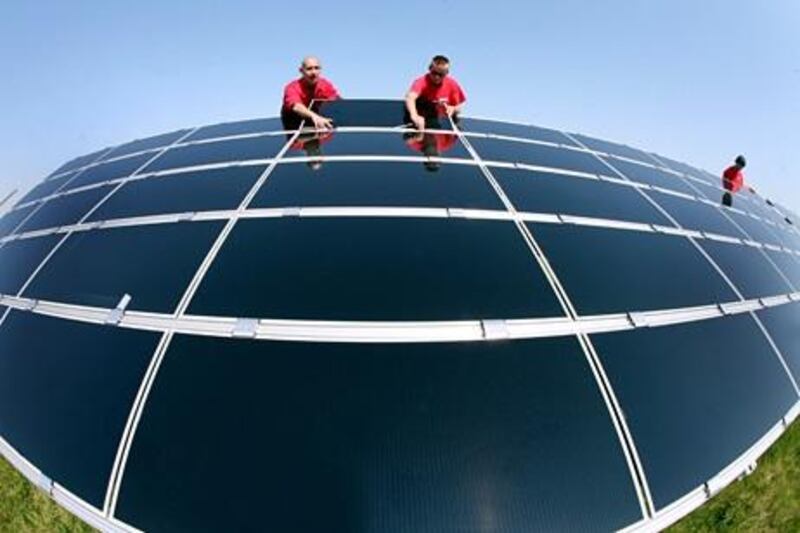One professional judgement on Europe's advances in providing power from renewable energy sources reads a little like a promising but inconsistent pupil's school report card: "Makes steady progress but could do better."
The detail of the assessment may become clear when delegates meet in Vienna for a three-day European conference, hosted by the Renewable Energy World and Power-Gen and starting on June 4.
The discussions should contain positive feedback as well as a few blunt messages to governments.
For example, businesses have increasingly recognised the advantages of "interruptible supply" contracts that bring lower power bills but allow cuts at specific periods.
Moreover, specialists in the field believe potential investors will respond favourably to gradual reductions in the cost of supplying renewable energy, up to 30 per cent a year in solar panels with less dramatic falls in wind and other technologies.
"Grid parity" - the point at which renewable energy competes on the wholesale market with traditional forms of generation such as coal, nuclear and gas - is expected within five to 10 years.
But Europe's deep and lasting economic crisis has affected the commitment of some countries.
This places greater pressure on the European Union as it urges member states to reinforce efforts to meet binding targets to reach a 20 per cent share of energy from renewable sources by 2020.
But the campaign to intensify the use of alternatives to nuclear power and fossil fuels does not end with that deadline. The European Renewable Energy Council (Erec), representing industry and research interests, says there is abundant potential throughout the EU for the "only true sustainable alternative to the energy system we currently have, in environmental, social and economic terms". Erec calls for a clear commitment to a 100 per cent renewable energy environment by 2050.
"Continuing on today's energy path without any change in policies would not only mean that the pressing issue of climate change is not addressed but also that our dependency on fossil fuels is set to increase," it says. "We would be bound to unpredictable energy prices, all of which would result in detrimental impacts on Europe's economy and in energy insecurity."
In this respect, the venue of the conference assumes particular significance. As the report cards are handed out, Austria is among the star pupils.
David Appleyard, Renewable Energy World magazine's chief editor and the conference director, believes "could do better" is a fair summary. But he hails Austrian efforts in his introductory remarks to delegates. According to the country's federal ministry of economy, the aim is to increase its share of energy from renewable supply to 34 per cent by the EU deadline for the much lower EU target to be attained.
Mr Appleyard says this "fundamental transition" was spearheaded by Verbund, the country's largest electricity provider, which supplies about 40 per cent of domestic electricity, mostly from more than 100 hydroelectric installations.
He cites comments by Wolfgang Anzengruber, Verbund's chief executive, that the company is focusing on wind, too. "Wind energy is the perfect supplement to hydropower and has the highest degree of competitiveness among all of the new forms of renewable energy," Mr Anzengruber said.
The key to maintaining and increasing investment may be for emphasis to be placed on renewable energy's claims to be a low-cost source. But responses to new development can be mixed, says Mr Appleyard, with occasional outbreaks of "banana syndrome" - the acronym standing for build absolutely nothing anywhere near anything.
Some within the industry say this attitude influences media and community opposition to energy-generating wind turbine projects in Britain and elsewhere, although not among more enthusiastic nations including Germany, Italy and Spain.
Industry observers point to the rise of the German company Juwi Holding, which builds facilities for solar, wind and bioenergy plants and promises to cover the entire process from site selection, planning and finance to operational management. It began as a two-man business in the mid-1990s and has grown to employ more than 900 with annual revenue nudging €1 billion (Dh4.75bn). The Waldpolenz Solar Park, at a disused military airbase near Leipzig, Germany, is one of its flagship projects. Its description is a mouthful - a thin-film photovoltaic power system, the world's largest when built - but the annual output of 52 million kilowatt hours of clean electricity, placing it among the world's top 10 solar power plants and meeting the needs of 13,000 households, is impressive.
In his message to conference delegates, Mr Appleyard says a more measured approach to the industry, driven by continuing economic challenges, has replaced the "apparently unconstrained growth" of a few years ago.
But, he adds, the outlook is still good. "Renewable energy continues to represent an attractive investment in Europe and beyond.
"There is no sign that ongoing concerns over climate change have abated and EU directives continue to deliver policy-backed support for renewables.
"What is changing is the dynamic of supply-demand across a range of fronts in response to the growing proportion of variable output renewables like wind and solar -demand-side management is one example but smart grid technology [and] storage are others that are emerging."






